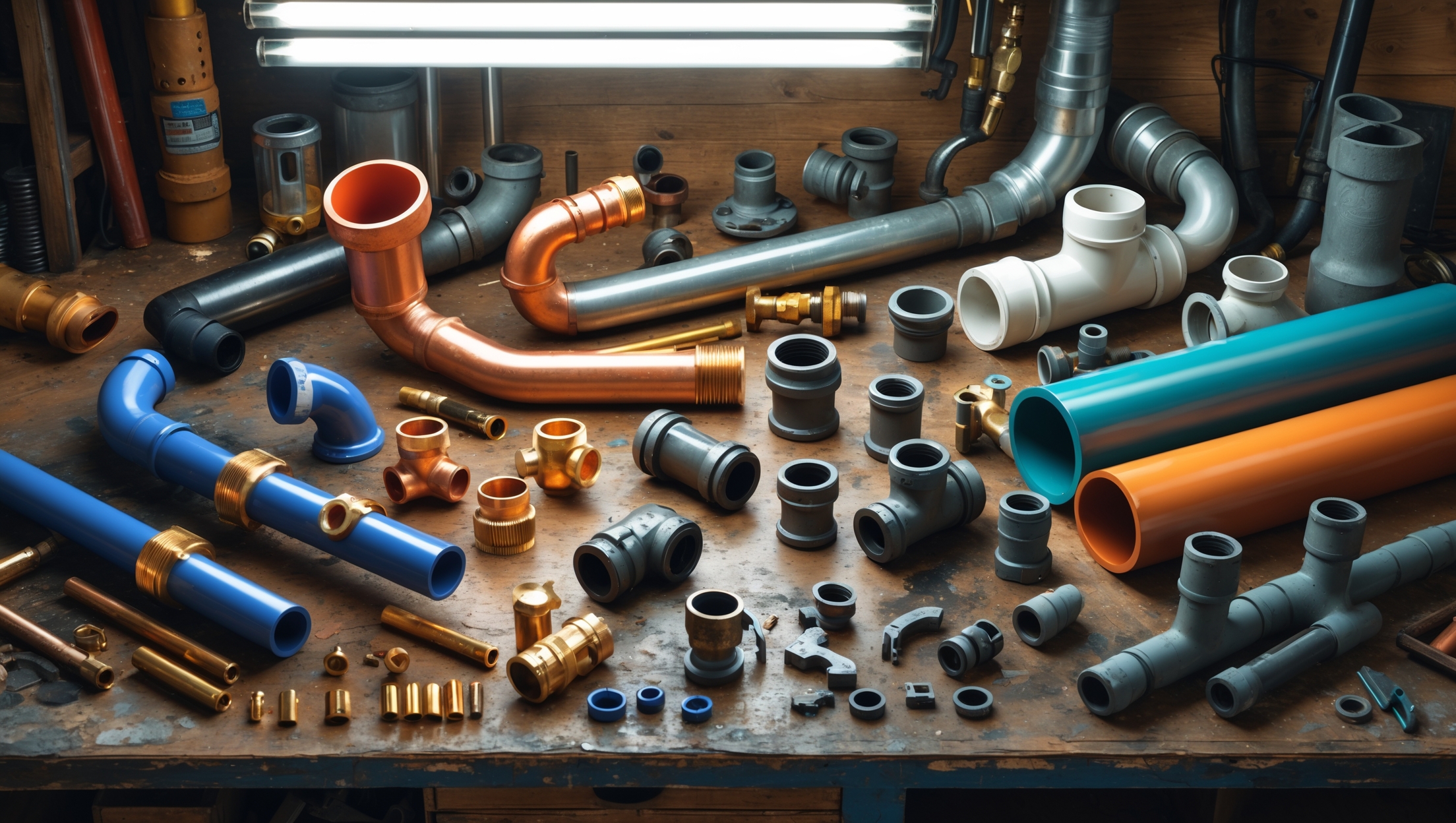Introduction: Making Sense of Plumbing Pipe Materials
Selecting the right pipe material is one of the most critical choices you’ll face in any plumbing project—whether it’s a full home repipe, a bathroom renovation, or a simple repair. With a growing range of options, including PVC, PEX, copper, CPVC, and galvanized steel, homeowners and professionals alike often feel overwhelmed. Each material comes with its unique strengths, drawbacks, and ideal uses. Choose wrong, and you could end up with leaks, corrosion, unnecessary costs, or even code violations down the line. Choose wisely, and you’ll enjoy a plumbing system that is reliable, cost-effective, and long-lasting.
This comprehensive guide breaks down the most common plumbing pipe materials available today. We’ll compare their performance, durability, costs, and ease of installation, helping you determine which is best for your specific project. Whether you’re a DIY enthusiast eager to tackle your first repipe or a seasoned contractor deciding between copper and PEX, you’ll find practical, expert-backed insights to support your decision and avoid costly mistakes.
Understanding the Main Types of Plumbing Pipes
PVC (Polyvinyl Chloride)
PVC pipes are a staple for drain, waste, and vent (DWV) systems. Lightweight and inexpensive, they resist corrosion and are easy to cut and join. However, PVC cannot handle hot water lines and is best reserved for cold water applications or venting.
- Pros: Affordable, easy to work with, corrosion-resistant, smooth interior reduces clogs.
- Cons: Not suitable for hot water, can become brittle with age or UV exposure, solvent welding required for joints.
- Best for: Drainage lines, vent pipes, cold water supply (where allowed).
CPVC (Chlorinated Polyvinyl Chloride)
CPVC looks similar to PVC but is engineered for higher temperature tolerance, making it suitable for hot and cold water supply lines. It is more expensive than standard PVC and requires special primers and cement for joining.
- Pros: Handles hot water (up to 200°F), corrosion-resistant, smooth flow.
- Cons: More expensive than PVC, can become brittle over time, can crack if frozen.
- Best for: Residential water supply lines, especially where hot water is needed.
PEX (Cross-linked Polyethylene)
PEX has revolutionized modern plumbing with its flexibility, ease of installation, and resistance to scale and chlorine. Available in red (hot), blue (cold), and white (universal), PEX can snake through tight spaces and requires fewer fittings.
- Pros: Extremely flexible, quick installation, resistant to freezing, minimal joints reduce leak risk, compatible with manifold systems.
- Cons: Sensitive to UV light (can’t be used outdoors unprotected), requires special tools for connections, not all municipalities allow PEX in walls.
- Best for: Whole-house water supply, remodels, retrofits in tight spaces.
Copper
Copper pipes are the gold standard for durability and longevity, with decades of proven performance. Available as rigid (Type L, M, K) and flexible (soft) tubing, copper resists bacteria and withstands high temperatures and pressures.
- Pros: Extremely durable, resists bacteria, doesn’t degrade in sunlight, recyclable, adds home value.
- Cons: Expensive, can corrode in acidic water, requires soldering skills, theft risk for exposed lines.
- Best for: Water supply lines, where longevity and reliability are priorities, visible installations.
Galvanized Steel
Once common in older homes, galvanized steel pipes are now mostly used for specific repair situations. Prone to internal rust and corrosion, these heavy pipes are rarely installed in new systems.
- Pros: Very strong, good for outdoor or exposed applications.
- Cons: Heavy, difficult to cut and thread, rusts internally, can leach lead if old fittings are present.
- Best for: Temporary repairs, outdoor non-potable water lines, matching existing systems.
Other Materials: ABS, Stainless Steel, Polybutylene
ABS (Acrylonitrile Butadiene Styrene) is occasionally used for DWV systems. Stainless steel is highly corrosion-resistant but costly. Polybutylene, once popular, is now avoided due to failure rates.
- ABS: Good for drain lines, but not always code-compliant.
- Stainless steel: Used in specialty applications; expensive but robust.
- Polybutylene: Avoid—known for premature failure.
Comparing Performance: Durability, Longevity, and Maintenance
Durability
Copper and PEX lead the pack for durability. Copper can last 50+ years under proper conditions, while PEX is expected to last 40–50 years. PVC and CPVC are durable when protected from UV and freezing. Galvanized steel is strong but prone to rust, which can reduce flow and introduce contaminants.
Longevity
- Copper: 50+ years (with proper water chemistry)
- PEX: 40–50 years
- PVC/CPVC: 25–40 years (protected from freezing/UV)
- Galvanized Steel: 20–50 years (but may fail sooner due to corrosion)
Maintenance Needs
PEX and copper require minimal maintenance if installed properly. PVC/CPVC can crack if exposed to freezing temperatures. Galvanized steel often needs replacement as rust builds up, leading to low water pressure and discoloration.
Cost Breakdown: Material, Labor, and Long-Term Value
Material Costs
- PVC: $0.40–$0.80 per foot
- CPVC: $0.50–$1.00 per foot
- PEX: $0.50–$2.00 per foot
- Copper: $2.00–$5.00 per foot (varies with market)
- Galvanized: $2.00–$4.00 per foot (rare in new installs)
Labor Costs and Installation Difficulty
- PVC/CPVC: Moderate DIY; requires cutting and solvent welding. Most can be installed with basic hand tools.
- PEX: Easiest DIY option; push-fit or crimp connections. Requires a crimp or expansion tool, but minimal skill.
- Copper: Professional recommended; requires measuring, cutting, cleaning, and soldering. Mistakes can be costly.
- Galvanized: Heavy, requires threading; rarely worth the effort for new work.
Long-Term Value
PEX and copper deliver the best long-term value due to their longevity and minimal maintenance. PVC/CPVC are economical upfront but can be costly to repair if buried or hidden behind walls. Copper adds home value and is universally accepted by inspectors and insurance companies.
Code Compliance and Environmental Considerations
Building Code Requirements
Local codes may restrict or specify certain materials. For example, some regions prohibit PEX in walls or require copper for potable water. Always check with your local building department before starting any plumbing project.
Environmental and Health Factors
- Copper: Recyclable, but energy-intensive to produce.
- PEX: Lower energy footprint, but not recyclable in most areas.
- PVC/CPVC: Contains chlorine and plasticizers; disposal and manufacturing raise environmental concerns.
- Galvanized: Can leach lead from old fittings; not recommended for potable water.
Application Guide: Matching Pipes to Projects
Whole-House Repiping
- Best Choices: PEX for cost and flexibility; copper for premium durability and resale value.
- Considerations: PEX is ideal for complex runs; copper is best for exposed or high-value properties.
Bathroom and Kitchen Remodels
- Best Choices: PEX or CPVC for supply lines; PVC or ABS for drains.
- Considerations: Use copper for visible runs; PEX in walls or tight spaces.
Outdoor and Specialty Uses
- Best Choices: Copper or galvanized for outdoor, above-ground; PEX for buried lines (with proper protection).
- Considerations: PEX should not be exposed to sunlight; copper performs best in exposed conditions.
Repairs and Retrofits
- Best Choices: Match existing material for small repairs; consider PEX for larger updates.
- Considerations: Use transition fittings for connecting different materials.
Installation Tips and Common Pitfalls
Cutting and Joining Pipes
Always use the right tool for the job—plastic pipe cutters for PVC/PEX, tubing cutters for copper, and a pipe threader for galvanized. Deburr and clean all cut ends to ensure leak-free joints. When joining different materials, use approved transition fittings (e.g., dielectric unions between copper and steel).
Supporting and Securing Lines
Proper support prevents sagging and stress. Use pipe straps every 3–4 feet for horizontal runs and at every floor level for vertical runs. PEX requires more frequent support due to its flexibility.
Pressure Testing
After installation, pressure-test your system per code to catch leaks before closing walls. Use water or air as specified by guidelines, and never exceed recommended pressures for your pipes.
Common Mistakes to Avoid
- Mixing incompatible pipe types without proper fittings (e.g., copper directly to steel).
- Exposing PEX or PVC to sunlight or extreme heat.
- Improper slope in drain lines (should be 1/4 inch per foot).
- Forgetting to secure permits or check code before starting work.
- Over-tightening fittings, which can crack plastic or deform copper.
Frequently Asked Questions
Can I mix different pipe materials in my plumbing system?
Yes, but use approved transition fittings to prevent corrosion or leaks. For example, a dielectric union is required between copper and galvanized steel to prevent electrolysis.
Is PEX safe for drinking water?
PEX is considered safe by most plumbing codes and is NSF-certified for potable water. However, check local regulations, as some areas restrict its use.
Should I replace old galvanized pipes?
Typically, yes. Galvanized pipes are prone to internal rust, which can reduce flow and cause water discoloration. PEX or copper are preferred replacements.
Conclusion: Choosing the Best Pipe for Your Plumbing Future
With so many options available, it’s crucial to match the pipe material to your project’s unique needs—balancing performance, cost, and code requirements. PVC and ABS remain staples for drain and vent lines, while PEX has become the go-to choice for water supply thanks to its flexibility and ease of installation. Copper, though more expensive, offers unmatched durability and is universally accepted by building inspectors. CPVC provides an affordable solution for hot water lines, while galvanized steel is best left to repairs in older systems.
Before starting any plumbing project, factor in not just the upfront material and labor costs, but also the long-term reliability, maintenance needs, and potential for future repairs. Always consult local codes to ensure your chosen material is approved for your intended use, and don’t hesitate to seek expert advice for complex installations or major renovations. Smart planning, informed choices, and precise installation are the keys to a trouble-free plumbing system that stands the test of time.
Whether you’re a homeowner planning a DIY upgrade or a plumbing professional advising clients, understanding the strengths and weaknesses of each pipe material is the cornerstone of a successful project. Invest the time to choose wisely, and your plumbing will reward you with years of dependable, leak-free service.










David Jackson
The article says each material has its ideal use cases. If I’m renovating an older home with existing galvanized steel pipes, is it possible or advisable to connect new PEX or copper lines to the existing steel, or should I plan a full replacement?